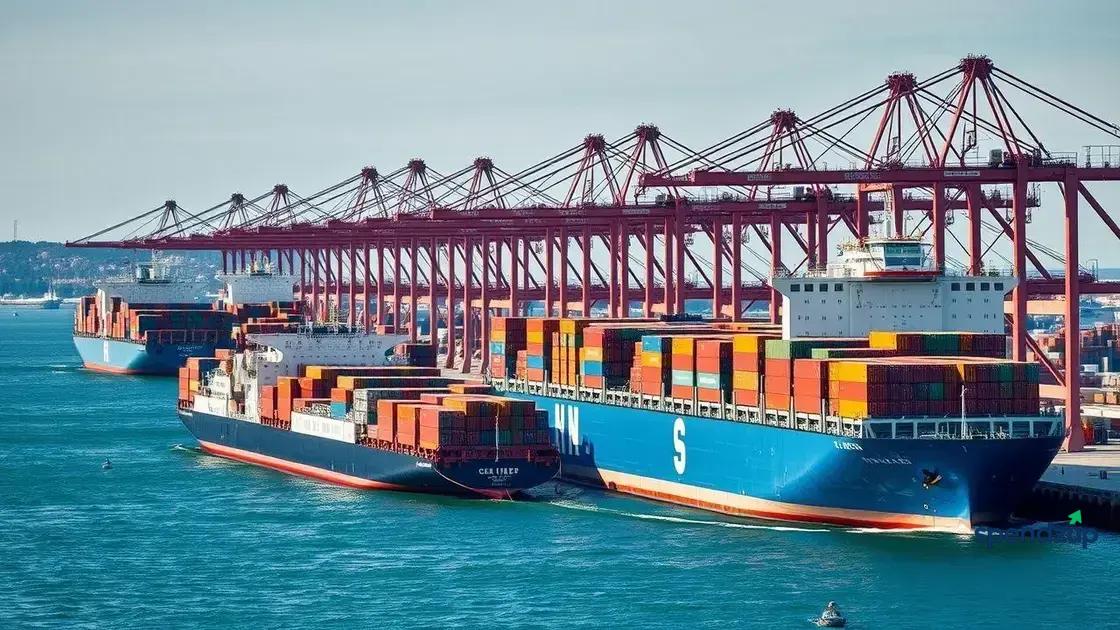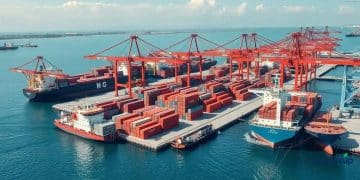WTO trade forecast downgrade: what it means for the economy

The WTO trade forecast downgrade indicates a significant reduction in expected global trade growth, affecting economies and supply chains, particularly in emerging markets.
The WTO trade forecast downgrade has significant implications for global commerce. Are you aware of how this might influence your business strategy? Let’s unpack the details and what they mean for the future.
Understanding the WTO’s trade forecast
Understanding the WTO’s trade forecast helps businesses grasp the dynamics of global trade movements. By analyzing these forecasts, companies can adapt their strategies in a rapidly changing environment.
The Importance of WTO Trade Forecasts
The World Trade Organization (WTO) plays a crucial role in monitoring and predicting trade patterns. Understanding these forecasts can provide valuable insights into international economics and market trends.
Business leaders often look at these forecasts to assess potential challenges and opportunities. A downgrade in the forecast could signal slower growth or even contraction in some regions. This information is vital for planning resources and investments effectively.
- Stay informed about regional trade changes
- Evaluate potential risks in supply chains
- Identify new markets that may emerge
Trade forecasts are more than just numbers. They reflect the realities faced by businesses worldwide and can influence decision-making at various levels. For instance, if the forecast predicts slower demand, companies might reconsider their inventory levels.
Analyzing the Factors Behind the Forecast
Several factors contribute to the WTO’s trade forecasts, including economic growth rates, consumer demand, and geopolitical stability. These elements interact in complex ways, making the forecasts both challenging and fascinating to analyze.
As a business, it’s essential to monitor these factors continuously. Changes in one area can have a ripple effect throughout the global trading system. For example, if a major economy is predicted to slow down, other trading partners may also feel the impact even if they are not directly affected.
In conclusion, understanding the WTO’s trade forecast is essential for aligning business strategies with the realities of global trade. By keeping a close eye on these insights, companies can navigate the complexities of the market more effectively.
Impact of the downgrade on global supply chains

The impact of the downgrade on global supply chains is significant. When organizations assess trade forecasts, any downgrade creates a ripple effect throughout various industries.
Understanding Supply Chain Vulnerabilities
Companies must recognize that supply chains can be vulnerable to fluctuations in trade forecasts. A negative adjustment means potential delays and increased costs. Businesses need to rethink their strategies to maintain efficiency while managing risks.
In times of uncertainty, companies often reconsider their suppliers and logistics partners. This can lead to:
- Increased scrutiny of supplier reliability
- Exploration of local sourcing options
- Adjustments in inventory management practices
It’s essential to build resilience within supply chains by diversifying suppliers. A more robust strategy can mitigate the effects of downgrades and enable companies to adapt more swiftly to changing market conditions.
Market Reactions and Adjustments
As forecasts shift, market reactions may include price fluctuations and changing consumer demands. These factors can further complicate supply chain management, making it crucial for businesses to stay agile. Tactical adjustments can involve:
- Optimizing logistics to reduce costs
- Investing in technologies for better visibility
- Developing contingency plans for disruptions
When a downgrade occurs, understanding these market dynamics helps companies gain an advantage. Firms that quickly adapt their supply chain strategies often outperform competitors who fail to react.
Sharing information and collaborating with stakeholders can improve visibility across the supply chain, allowing for more informed decision-making. Keeping communication open is vital during downgrades, ensuring that all parties are aligned.
Effects on emerging markets and economies
The effects on emerging markets and economies due to trade forecast downgrades can be profound. These regions are often more sensitive to fluctuations in global trade dynamics, making them especially vulnerable.
Challenges Faced by Emerging Economies
Emerging markets often depend heavily on exports for growth. A downgrade in global trade forecasts typically signals reduced demand for these exports. As a result, economies may experience:
- Slower economic growth rates
- Increased unemployment rates
- Trade deficits as imports outpace exports
These factors can create a cycle of economic instability, where the negative impacts perpetuate further weaknesses in the market. It’s critical for these nations to adapt quickly to mitigate these effects.
Opportunities Amidst Adversity
While the challenges are real, there can also be opportunities. Nations that can pivot quickly may attract foreign investment by offering stability and growth potential. For example:
- Investing in technology and infrastructure
- Fostering local industries to lessen reliance on exports
- Enhancing trade agreements with diverse partners
Investing in education and workforce development can prepare the population for a changing economic landscape. Emerging markets that position themselves as adaptable and innovative are more likely to thrive.
A strong governmental response and collaboration across sectors are essential. Establishing policies that support small and medium enterprises can strengthen these economies. This approach not only aids in sustaining growth during downturns but also builds resilience for the future.
Strategies for businesses to navigate challenges

Businesses can implement various strategies to navigate challenges arising from trade forecast downgrades. These strategies are vital to maintaining stability and supporting growth amid uncertainty.
Adapting Business Models
Companies often find it necessary to adapt their business models to changing market conditions. This may involve focusing on innovation, customer engagement, and flexibility. Key strategies include:
- Exploring new revenue streams
- Enhancing online presence and e-commerce
- Creating value-added services for customers
By shifting focus to adaptability, businesses can respond effectively to changing demands and reduce risks associated with reliance on a single market or product.
Strengthening Supply Chains
A robust supply chain is crucial during challenging times. Businesses should consider diversifying suppliers or sourcing materials from different regions. This can minimize the risks brought by geopolitical tensions or logistic disruptions. Important actions include:
- Establishing relationships with multiple suppliers
- Implementing technology for supply chain visibility
- Developing contingency plans for disruptions
Through diversifying and strengthening supply chains, businesses can maintain smoother operations, even when facing external pressures.
Additionally, investing in talent development is essential. A skilled workforce enables companies to innovate and improve processes continuously. Upskilling employees ensures adaptability to market changes and technology advancements, ultimately enhancing company resilience.
Engaging stakeholders through transparent communication helps foster trust and cooperation. Keeping everyone informed allows for better alignment and faster response to market fluctuations. Collaboration with partners and customers can lead to new opportunities and solutions in times of uncertainty.
Future outlook for global trade recovery
The future outlook for global trade recovery shows signs of cautious optimism. As economies begin to rebound from recent challenges, understanding these trends is essential for businesses engaged in international commerce.
Positive Indicators for Recovery
Several indicators suggest that global trade may enter a recovery phase. Consumer demand is gradually increasing in many regions, leading to higher imports and exports. Analysts highlight factors such as:
- Improvement in global supply chain efficiencies
- Rising confidence among businesses and consumers
- Increased investment in technology and infrastructure
These elements can help facilitate smoother trade operations and reduce some uncertainties that have plagued the market.
Challenges Ahead
However, challenges remain that could hinder the pace of recovery. Issues like geopolitical tensions, inflationary pressures, and potential disruptions in supply chains must be carefully monitored. Businesses should stay aware of:
- Global political dynamics affecting trade policies
- Fluctuating commodity prices impacting production costs
- Ongoing effects of the pandemic in different regions
To prepare for these challenges, companies must build flexibility into their operations. Establishing diverse supplier networks and logistics solutions can provide an edge in managing risks effectively.
Looking ahead, engaging in proactive scenario planning will be vital. This approach allows businesses to anticipate potential shifts in market conditions and adjust strategies accordingly. Collaboration across the supply chain can also enhance resilience and adaptation to changing environments.
The evolving landscape of global trade presents both opportunities and uncertainties. Organizations that remain agile and informed will be better positioned to navigate these complexities and succeed in a recovering market.
In summary, navigating global trade challenges and opportunities
The landscape of global trade is constantly changing, especially in light of recent downgrades in forecasts. Businesses must remain informed and adaptable to succeed. Understanding the implications for emerging markets, strengthening supply chains, and developing sound strategies are essential.
As we look to the future, the potential for recovery is tied to proactive planning and collaboration. By focusing on resilience and innovation, companies can harness new opportunities while preparing for challenges.
Moving forward, staying flexible and engaged with global trends will be key to thriving in this dynamic environment. Embrace the changes coming in global trade and use them to your advantage.
FAQ – Frequently Asked Questions About WTO Trade Forecasts
What is the impact of a WTO trade forecast downgrade?
A WTO trade forecast downgrade can lead to reduced consumer demand and slower economic growth, affecting businesses reliant on exports.
How can businesses prepare for global trade challenges?
Businesses can prepare by diversifying suppliers, optimizing supply chains, and developing flexible strategies to adapt to market changes.
What challenges do emerging markets face in global trade?
Emerging markets often encounter slower growth, increased unemployment, and trade imbalances due to their heavy reliance on exports.
What strategies can support global trade recovery?
Strategies include investing in technology, enhancing local production, and maintaining strong communication with stakeholders to navigate uncertainties.





